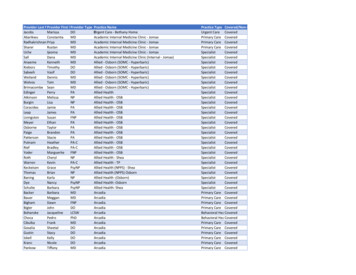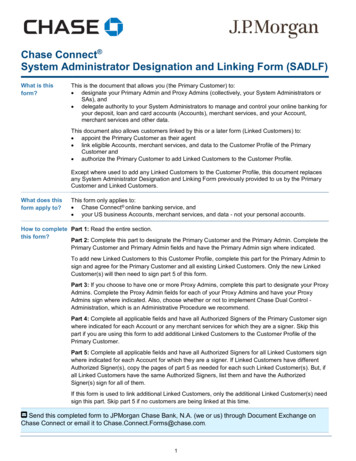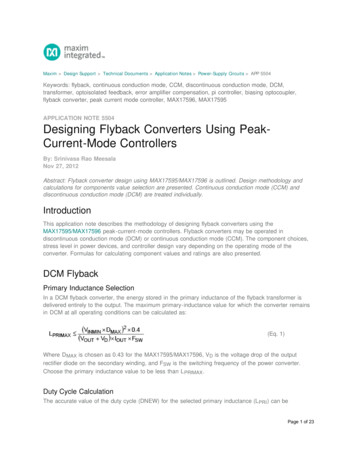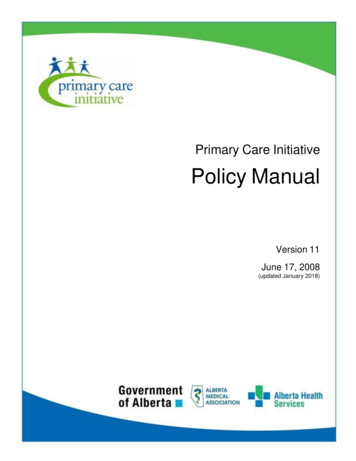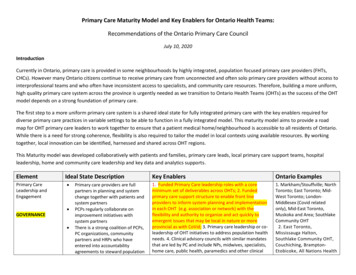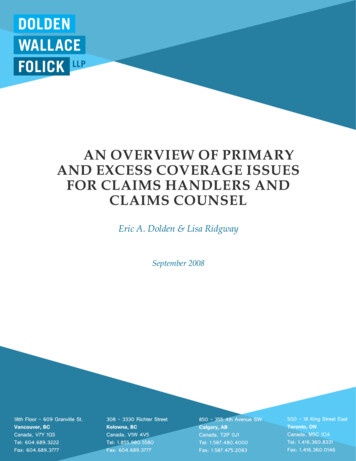
Transcription
AN OVERVIEW OF PRIMARYAND EXCESS COVERAGE ISSUESFOR CLAIMS HANDLERS ANDCLAIMS COUNSELEric A. Dolden & Lisa RidgwaySeptember 2008 Dolden Wallace Folick LLP1
CONTACT LAWYEREric Dolden604.891.0350edolden@dolden.comTABLE OF CONTENTS1.Definitions .2a.Primary Insurance: .3b.Excess Insurance:.3i)Follow-Form Excess Insurance .4ii)Umbrella Excess Insurance .4iii)“Other Insurance” Clauses .42.The First Question: Is the Policy Primary or Excess? .53.The “Duty to Defend” of Excess Liability Insurers .94.Allocation of Defence Costs Between the Primary and ExcessLiability Insurer .135.Carriage of the Defence of the Underlying Claim .186.Failure to Settle at Primary Limits .197.Disputing the Exhaustion of the Primary Liability Insurer’s Policy .208.Excess Directors & Officers Insurance and Coverage Issues .219.Breach of the Primary Policy by the Insured .2510.IBC Guidelines: Agreement of Guiding Principles .2511.Conclusion .26Appendix A.27IBC Agreement of Guiding Principles Between Primary andExcess Liability Insurers Respecting Claims and Listof Signatories .271 Dolden Wallace Folick LLP
AN OVERVIEW OF PRIMARY AND EXCESS COVERAGE ISSUESFOR CLAIMS HANDLERS AND CLAIMS COUNSELThe focus of this paper is the nature of the relationship between the primary and theexcess liability insurer and in particular the issues that may arise when the exposure toa claim may be in excess of the primary limits. This paper is a “primer” for claimshandlers and claims counsel; it reviews the basic rights and duties of the primary andexcess liability insurer in a variety of contexts including the broader picture of the “dutyto defend” and the allocation of defence costs. Questions such as who appoints defencecounsel and issues in regard to settling claims when primary and excess liabilityinsurers are involved are addressed. The paper concentrates on disputes betweenprimary and excess insurers in the context of general liability policies with someattention given to the newly emerging issue of whether the insured can contribute to asettlement in an effort to exhaust a policy layer and “trigger” any ensuing excesscoverage. Finally, this paper reviews the IBC “Agreement of Guiding Principlesbetween Primary and Excess Liability Insurers Respecting Claims” as the industrycode-of-conduct that most Canadian liability insurers have agreed to follow.There are relatively few Canadian cases that address the relationship between primaryand excess liability insurers, but many more from the American courts. While thispaper focuses on Canadian law, some American cases are reviewed to round out thediscussion.1.DEFINITIONSWhat is the difference between primary and excess insurance? What is the differencebetween excess coverage and excess umbrella coverage? In resolving issues betweenliability insurers, the first thing a Court decides is whether a particular policy offersprimary, excess or umbrella excess coverage to the insured. This first determinationunderpins the competing liability insurers’ obligations to the insured, and to each other. Dolden Wallace Folick LLP2
a.Primary Insurance:Simply put, primary insurance is front line indemnity:Primary insurance coverage is insurance coverage whereby, under theterms of the policy, liability attaches immediately upon the happening ofthe occurrence that gives rise to the liability.1b.Excess Insurance:Excess policies are, by definition, in excess to whatever coverage is offered by anotherpolicy. Liability attaches only after whatever predetermined amount of primarycoverage has been exhausted.An excess policy is one that provides that the insurer is liable for theexcess above and beyond that which may be collected on primaryinsurance.2The main purpose of excess insurance is to protect from any sort of loss in excess ofwhatever coverage was provided by the primary or underlying insurance. It seemsobvious but before there can be an excess policy, there must be a primary policy inexistence.3 Normally, excess policies are less expensive for an insured to obtain becausethe risk of having to pay out a claim is lower, since there is already one layer of primaryinsurance in place. Excess policies are generally written with the expectation that theprimary liability insurer will conduct the investigation, negotiation and defence of theclaims until primary limits are exhausted.4St Paul Mercury Insurance Company v. Lexington Insurance Company, 78 F. 3d 202 (5th Cir. 1996) atfootnote 23, quoting from Emscor Mfg. Inc. v. Alliance Ins. Group, 879 S.W. (2d) 894 at 903 (Tex App. 1994,writ denied) as quoted in Trenton Cold Storage Ltd. v. St. Paul Fire and Marine Insurance Co, [2001] O.J. No.1835 at page 7.2 St Paul Mercury Insurance Company v. Lexington Insurance Company (supra).3 Beck v. Budget Rent-A-Car, 669 N.E. 2d 1335, 1338 (Ill App.1996) as quoted in M. Marick & K. Dixon,“What’s Privity Got to Do with It” (2003) Insurance Coverage and Claims Institute, at page 126.4 Progressive Case. Ins. Co. v. Travellers Ins. Co. 735 F. Supp. 15,19 (D.Me.1990) as quoted in M. Aylward,“Scenes from the New Civil War: Selected Areas of Dispute between Primary and Excess Insurers” (2001)Insurance Coverage and Claims Institute, at page 298.1 Dolden Wallace Folick LLP3
There are several kinds of excess insurance:i) Follow-Form Excess InsuranceFollow-Form excess insurance is coverage that is intended to ensure that the higherlayers of coverage follow consistently the primary or lower layers of coverage. Theterms or clauses in a follow-form excess policy are normally very closely based on theterms of the underlying primary policy (or a lead umbrella policy) and may incorporateby reference the terms of the underlying coverage. Endorsements may providedifferent wording from the primary policy.ii) Umbrella Excess InsuranceAn umbrella policy is a hybrid policy that combines aspects of both a primary policyand an excess policy. These types of policies generally provide two types of coverage:standard form excess coverage and broader coverage than the primary policy, includingthe duty to defend lawsuits not covered by the underlying coverage. 5The two functions of the umbrella excess policy are as follows:1.To provide for a higher limit of liability for losses typically coveredby liability insurance, such as general liability and comprehensiveauto liability for bodily injury and property damage; and2.To provide for some coverage for less common losses not typicallycovered by liability insurance, including malpractice liability,advertiser’s liability and blanket contractual liability. 6iii) “Other Insurance” ClausesMany liability insurance policies contain an “other insurance” clause. A conflict oftenarises when two competing liability insurers have issued primary policies that cover thesame loss, and one contains an “other insurance” clause; cases with these facts arediscussed in detail below. An example of an “other insurance” clause is:This insurance does not cover any loss, which at the time of the happeningof the loss, is insured by or would but for the existence of this Policy, beTrenton Cold Storage Ltd. v. St Paul Fire and Marine Insurance, (supra) at page 7.Ridgway v. Gulf Life Insurance Co., 578 F.2d 1026, 1030 (5th Cir. 1978) as quoted in Garmany v. Mission Ins.Co. 785 F2d 941, 948 (11th Cir. 1986) at page 9.56 Dolden Wallace Folick LLP4
insured by any other existing Policy or Policies except in respect of anyexcess beyond the amount which would have been payable under suchother Policy or Policies had this insurance not been effected.72.THE FIRST QUESTION: IS THE POLICY PRIMARY OR EXCESS?How do the Courts allocate indemnity as between competing liability insurers? Adispute between liability insurers is very different in the eyes of the Court to a disputebetween the insurer and its insured. To resolve this question, a Court will review thewording of the policies; it will not review the circumstances surrounding the making ofthe contract itself. The cases discussed below illustrate how the Courts address thiscentral issue, namely the proper approach to the characterization of a policy of liabilityinsurance.In the case of Family Insurance Corp. v. Lombard Canada Ltd.8 the Supreme Court ofCanada was faced with two competing liability insurers who each relied on “otherinsurance” clauses as a means of raising a shield to primary indemnity. On thequestion of interpretation, the Court stated:Once the interest of the insured is no longer at stake, that is, where thecontest is only between the parties, there is simply no basis for lookingoutside the policy. In the absence of privity of contract between theparties, the unilateral and subjective intentions of the insurers, unaware ofone another at the time the contracts were made, are simply irrelevant.9The two liability insurers each argued that their individual policies only providedexcess coverage. The Family policy contained the following “other insurance” clause:If other insurance exists which applies to a loss or claim or would haveapplied if this policy did not exist, this policy will be considered excessinsurance and the Insurer is not liable for any loss or claim until theamount of such other insurance is set up.10The Lombard policy contained a different “other insurance” clause:Trenton Cold Storage Ltd. v. St Paul Fire and Marine Insurance (supra) at page 4.[2002] 2 S.C.R. 695.9 Family Insurance Corp v. Lombard Canada Ltd. (supra) at page 707.10 Family Insurance Corp. v. Lombard Canada Ltd. (supra) at page 700.78 Dolden Wallace Folick LLP5
If other valid and collectible insurance is available to the Insured for a losswe cover under Coverages A, B, or D of this form, our obligations arelimited as follows:This insurance is excess over other existing insurance if any,whether such other insurance be primary, excess, contingentor on any other basis, that is liability insurance such as, butnot limited to comprehensive personal liability,comprehensive general liability coverages or similarcoverage for liability arising out of the activities of anyinsured.11If the Court had accepted that both the Family and Lombard policies were excess, theinsured would have been left with no primary coverage at all. In its reasons, theSupreme Court of Canada stated:[w]here the competing policies cannot be read in harmony, the mostsensible course, and what accords with the interest and expectation ofboth the insured and the insurers, is to treat the conflicting clauses asmutually repugnant and inoperative.With the irreconcilable clauses rendered inoperative, the insurancepolicies of both the appellant and the respondent provide the insured withprimary coverage. As a result, each insurer is independently liable to theinsured for the full loss, as if the other insurer did not exist. Thus, whatremains to be determined is the method by which the extent of eachinsurer’s obligation to contribute is calculated. The overwhelming view inCanada is that where liability is shared among insurers covering the samerisk, the loss is borne equally by each insurer until the lower policy limit isexhausted, with the policy with the higher limit contributing anyremaining amounts.12The Family Insurance case (supra) remains the benchmark in Canadian law to interpretprimary and excess policies. The decision has acute relevance in cases between twoprimary insurers whose policies have similar “other insurance” clauses; facts which alsolimit the application of the case. The Ontario Court of Appeal in its 2007 decision inMcKenzie v. Dominion of Canada General Insurance Co.13 reviewed Family (supra) andFamily Insurance Corp. v. Lombard Canada Ltd. (supra) at page 700.Family Insurance Corp. v. Lombard Canada Ltd. (supra) at page 716.13 McKenzie v. Dominion of Canada General Insurance Co. 2007 ONCA 480, [2007] I.L.R. I-4612 (Ont C.A.)1112 Dolden Wallace Folick LLP6
noted the limiting aspect. In Family (supra), the Court was faced with two primarycarriers and pronounced on the validity of “other insurance” clauses between similarlayers of insurance. In McKenzie (supra) the contest was between policies of insuranceproviding different layers of coverage. For claims handlers and claims counsel, thisdistinction is key.The facts in McKenzie (supra) demonstrate the difference. A boat driver sought coverageunder three separate policies; a boat owners policy, an “umbrella” liability policy and ahomeowners policy. At issue was the order in which the latter two policies wererequired to contribute. After reviewing the wording of the policies, the Court foundthat the policies covered different layers of risk. An umbrella policy was not calledupon to respond to claims until the limits of the second layer (in this case, thehomeowners insurance) were exhausted.The question of which policy is excess and which is primary is critical because theprimary policy responds first. In the 2001 case of Trenton Cold Storage Ltd. v. St Paul Fireand Marine Insurance Co.14 the Ontario Court of Appeal overturned the trial decision thatthe two competing liability insurers (IARW and St. Paul) were to contribute equally tothe Plaintiff’s loss. IARW was seeking contribution from St. Paul towards defence costsand the settlement which it paid in the underlying action.The case turned on the wording of the respective policies. The Court of Appealconstrued each policy as a whole, not by its separate provisions. First, nothing in thewording of the “deemed” primary policy of IARW showed an intent to provideanything other than primary insurance. The “other insurance” clause in that policygave the insured permission to obtain “ other insurance being the excess ofinsurance”. The St. Paul policy, on the other hand, expressly obligated the insured tomaintain underlying insurance. The Court concluded that IARW was the primaryliability insurer and it could not use an “other insurance” clause to require the umbrellaexcess insurer to equitably contribute to its liability. As a result, since primary coveragehad not been exhausted, St. Paul was not required to contribute to the settlement of theunderlying tort action. This case is significant for two reasons:141.it shows that the Courts will review the insuring intent of the entirepolicy, not just the individual clauses within a policy to reach theirconclusions; and2.it illustrates a failed attempt by an admitted primary insurer,IARW, using its “Other Insurance” clause, to characterize aTrenton Cold Storage Ltd. v. St Paul Fire and Marine Insurance Co, [2001] O.J. No. 1835 (C.A.) Dolden Wallace Folick LLP7
seemingly admitted excess insurer, St Paul, as a co-primary liabilityinsurer.This case was followed in the 2004 Ontario Court of Appeal ruling in Lombard GeneralInsurance Co. v. CGU Insurance Co. of Canada.15 At trial, Lombard sought a declarationcompelling CGU to satisfy a shortfall on a judgment in the underlying lawsuit whichexceeded the Lombard limit. The Court noted the different wording between the CGUand Lombard policies. The Lombard policy had a clause which referred to “underlyinginsurance”. Similar wording was not found in the CGU policy. The Court found thatthe CGU policy was primary, and the Lombard policy was an umbrella policy, whichobliged Lombard to respond to the claim only after the limits of the CGU policy hadbeen exhausted. On appeal, the Court of Appeal upheld the ruling that CGU hadissued a primary policy with an excess coverage clause, while the Lombard policy wasexcess. The Court of Appeal concluded that “ the law is clear that the primary policywith excess coverage ranks ahead of the umbrella policy”16 which meant that in the end,Lombard only had to respond to the claim after the limits of the CGU primary policyhad been exhausted. This case demonstrates a similarly unsuccessful effort, not unlikeTrenton Cold Storage (supra), by a primary insurer to have an excess liability policycharacterized as co-primary.These cases are significant because they establish that when Courts are interpretingcompeting liability insurers’ policies, the Court will:15161.review the contracts between competing liability insurers, not thecircumstances surrounding the underwriting of the policies;2.review the policies as a whole, not by specific clauses out of contextto the entire policy; and3.in examining the entirety of the policies, the presence of featurestraditional to excess policies, including a reference to the “scheduleof underlying coverages”, will largely prevent an admitted primaryliability insurer from using its “Other Insurance” clause to convertan excess policy into a “co-primary” liability policy.[2003] O.J. No. 3385 (upheld on appeal to the Ontario Court of Appeal in 2004)Lombard General Insurance Co. v CGU Insurance Co. of Canada [supra] at page 1. Dolden Wallace Folick LLP8
3.THE “DUTY TO DEFEND” OF EXCESS LIABILITY INSURERSTwo critical areas of dispute between primary and excess liability insurers arise whenthe indemnity exposure may be in excess of primary liability policy limits. First, whendoes the excess liability insurer have a “duty to defend” in whole or in part? Second,when does the excess liability insurer have an obligation to contribute to defence costs,and by how much? (This latter question is addressed in the following section of thepaper). The two issues are inextricably linked. Ultimately the question for both claimshandlers, claims counsel and before the Courts when faced with competing liabilityinsurers is which liability insurer pays what amount and when.The terms of the policy provide the cornerstone for the Court to determine whether theexcess liability insurer has a “duty to defend”. In many cases, an excess insurer’s policymay contain either an express “duty to defend” clause, or, the policy may incorporateby reference or endorsement a “duty to defend” clause contained in the underlyingpolicy. It is always open to an excess liability insurer to alter the nature of thecontractual “duty to defend” by including appropriate express language in the policy.The Courts have extrapolated from the many “duty to defend” cases, decided in thecontext of a single policy, to determine whether there is a “duty to defend” in cases ofcompeting liability insurers.17There are several seminal decisions in Canadian law dealing with an excess liabilityinsurers “duty to defend”. These cases also address the concurrent issue of allocation ofdefence costs (discussed in the next section). The first is the 1990 decision of the OntarioCourt of Appeal in Broadhurst & Ball v. American Home Assurance Co.18 This caseconcerned two liability insurers; American Home issued a primary policy whileGuardian Insurance Company issued an umbrella policy (described as “excess” in thereasons) to provide professional liability insurance to a law firm. Each policy provideda broad defence obligation that the liability insurer would defend the insured in anyaction and pay any expenses associated with the defence. The damages claimed in theunderlying tort action would have exhausted the limits of the primary policy.Guardian argued that its “duty to defend” did not arise when the obligation wascovered under a primary policy, especially in light of a “retention clause” in its policywhich, it argued, relieved it of any defence obligation. The Court of Appeal decidedthat both insurers had a “duty to defend” and stated:Among the seminal cases are Non-Marine Underwriters, Lloyd’s of London v. Scalera, [2000] 1 S.C.R. 551,185 DLR 9 (4th) 1, and Nichols v. American Home Assurance Co., [1990] 1 S.C.R. 801 at 808-809, 678 DLR(4th) 321.18 (1990), 1 O.R. (3d) 225 (C.A.) leave to appeal to the Supreme Court of Canada refused (1991), 79 DLR(4th) vi, [1991] S.C.C.A. No. 55.17 Dolden Wallace Folick LLP9
In these circumstances Guardian ought not to be entitled to excuse its nonperformance of its obligations to defend by pointing to the defence beingprovided by another insurer and insisting that that insurer’s defencerelieves it of any obligation to involve itself in the defence. To conclude,as did the court below, on the one hand, that Guardian has a clearcontractual duty to defend the respondents under the terms of its policy,and, on the other hand, that Guardian need do nothing in furtherance ofthe defence but may stand by and have the primary insurer bear the entireburden of the defence, is to render the contractual duty meaningless, and,at the same time, to confer a windfall on Guardian by permitting it to haveits defence obligations discharged by another insurer.19The ruling in this case is very specific to the facts: where there are concurrent andunqualified duties to defend in both the primary and excess policy, both insurers have a“duty to defend”.Additionally, one of the liability insurers in Broadhurst & Ball v. American HomeAssurance Co. (supra) was not a signatory to the IBC “Agreement of Guiding PrinciplesBetween Primary and Excess Liability Insurers Respecting Claims” discussed later inthis paper.20 The IBC Agreement is not law but rather only a guideline for liabilityinsurers. It states that any excess liability insurer who signs the agreement agrees toshare equally with a primary liability insurer in legal costs, and the sharing will beadjusted following the final resolution of the claim to a pro-rated share of the indemnityfor the claim.The second leading case which addresses the “duty to defend” of the excess or umbrellaliability insurer (and the concurrent issue of the allocation of defence costs whenexposure is well beyond primary limits, as discussed next) is the Ontario Court ofAppeal ruling in Alie et al v. Bertrand & Frere Construction Company Limited et al; BorealInsurance Inc et al .21 At trial, a concrete supplier and a producer were found liable fordamages to homes negligently constructed with defective concrete foundations.Damages in the case were found to be over 20 million with legal costs estimated in thesame range. Both the supplier and producer had several primary and many excess CGLpolicies which offered coverage over the 16 years during which the progressive orcontinuous property damage arose.Broadhurst & Ball v. American Home Assurance Co. (supra) at page 13.C.B. Brown et al., Insurance Law in Canada, v.2 (Toronto: Thomson Carswell, 2002) at pages 18-35.21 (2002), 222 DLR (4th) 687, [2002] O.J. No. 4697 (Q.L.)(C.A.) (appeal to SCC denied).1920 Dolden Wallace Folick LLP10
Nine different appeals (and various cross-appeals) were brought by the liabilityinsurers of the concrete supplier and the producer. Most of the excess insurers’ policiescontained either an express “duty to defend” clause, or, incorporated by reference a“duty to defend” clause contained in an underlying policy. In regard to the issue of the“duty to defend” of the excess liability insurers, the Court of Appeal stated:.where a policy provides a duty to defend, the operation of that duty willbe determined prospectively by reference to the allegations made in theclaim unless the policy expressly indicates to the contrary. If the insurer ispotentially liable to indemnify under the terms of the policy, the insurerwill be obligated to defend.the prospective determination of a duty todefend also facilitates the expeditious resolution of claims made againstthe insured through the early involvement of the insurer who mayeventually have to indemnify the insured. We see no reason, however, to depart from the presumption in favourof a prospective determination of a duty to defend based on the nature ofthe claims made where it is an excess insurer that has undertaken thatobligation. It is always open to the excess insurer to alter the nature of the duty todefend by including the appropriate express language in the policy.22 (emphasisadded)Accordingly, the Court imposed a defence obligation on the excess and the umbrellaliability insurers based on the clear risk of the claim exceeding primary limits, thebenefit that would potentially accrue to the umbrella carriers, and the high costs ofdefending the action.23 The issue of allocation of costs is addressed in the next sectionof this paper.A third case addresses the question of the obligations of both the primary and excessliability insurers to defend once the primary limits of indemnity have been reached (incontrast to when a primary liability insurer whose limits are not exhausted conducts adefence of the claim that might benefit the excess liability insurer, which might call forequitable contribution.) The Ontario Superior Court considered the first question in thecase of Boreal Insurance Inc. v. LaFarge Canada Inc.24 a companion case arising out of thesame occurrences as Alie v. Bertrand (supra). Here, the concrete supplier made anapplication to determine whether its primary liability insurer had a “duty to defend”Alie et al v. Bertrand et al (supra) at page 741.M.B. Snowden “Dropping Umbrellas and Following to Excess” (2004), Canadian Institute Conference onInsurance Coverage Disputes at page 29.24 [2004] O.J. No. 1571 (Q.L.)(Sup. Ct.)2223 Dolden Wallace Folick LLP11
despite the limits of indemnity being exhausted. Additionally, the Court was asked todecide whether the excess liability insurers were required to defend if the primaryliability insurers were not.The Court, as always, went directly to the policy wording to answer these questions. Itdetermined that absent any clear and certain statement in the policies in question thatthe excess liability insurers would not defend against claims in these circumstances, the“duty to defend” devolved to the excess insurer once the limits were exhausted. TheCourt in Boreal v. Lafarge (supra) stated:The underlying theory behind this allocation is that because the claimsexceed the primary limits, the duty to defend relates to that part of theclaims for which there is a possible indemnity. I find that it follows fromthis theory that, where there is no possible indemnity because the limitshave been exhausted, the duty to defend passes to the next insurer in thelayered scheme.25The Court also stated if a primary liability insurer, in the absence of any “stacked”excess insurance, simply abandoned a defence once limits are exhausted, there wouldbe redress available to the insured to deal with any resulting unfairness.26This case in regard to the “duty to defend” between a primary and excess liabilityinsurer also establishes that:1.A primary liability insurer is not required to defend an action oncethe limits in the insurance policy have been exhausted (subject tothe above caveat); and2.An excess liability insurer is required to defend an action once thepolicy limits of the primary insurance policy have been exhausted.Building on this body of law is the recent ruling of St. Mary’s Cement Co. v. ACE INAInsurance,27 in which the Ontario Superior Court reviewed an excess policy thatincluded an express duty to defend. The insured, a concrete powder supplier, hadumbrella liability coverage through a policy which stated that it would indemnify whenthe “ limits of liability of the underlying insurance are exhausted because of, inter alia,property damage”. The policy also provided that where those conditions were met, theBoreal Insurance Inc. v. Lafarge Canada Inc. (supra) at page 11.Boreal Insurance Inc. v. Lafarge Canada Inc. (supra) at page 10.27 2008 WL 2624084, 2008 CarswellOnt 3838 (Sup. Ct.)2526 Dolden Wallace Folick LLP12
insurer had a duty to defend. In this case, the insured was faced with 18 legal actions,with damage claims over 27 million dollars; an amount well over the limits of itsprimary coverage and, if the claims were proven, well within the coverage provided bythe insurer. The Court stated:[w]here an excess insurance policy includes a duty to defend, theinsurer may be called upon to provide that defence or to contribute to thatdefence before it is known whether the primary policy will beexhausted. That is, the duty to defend is to be determined prospectively.28(emphasis added)The Court referred at length to Alie v. Bertrand (supra), particularly the reasoning thateven the possibility that an excess insurer will be required to indemnify the insured ifthe claim is successful may be suffice to trigger a duty to defend. Put another way, itwas not necessary to prove that an obligation to indemnify would in fact arise in orderto trigger a duty to defend.4.ALLOCATION OF DEFENCE COSTS BETWEEN THE PRIMARY ANDEXCESS LIABILITY INSURERAs discussed earlier, a critical question for claims handlers, claims counsel and forexcess liability insurers is at what point in a claim involving layers of coverage
covered by liability insurance, including malpractice liability, advertiser's liability and blanket contractual liability. 6 iii) "Other Insurance" Clauses Many liability insurance policies contain an "other insurance" clause. A conflict often arises when two competing liability insurers have issued primary policies that cover the



